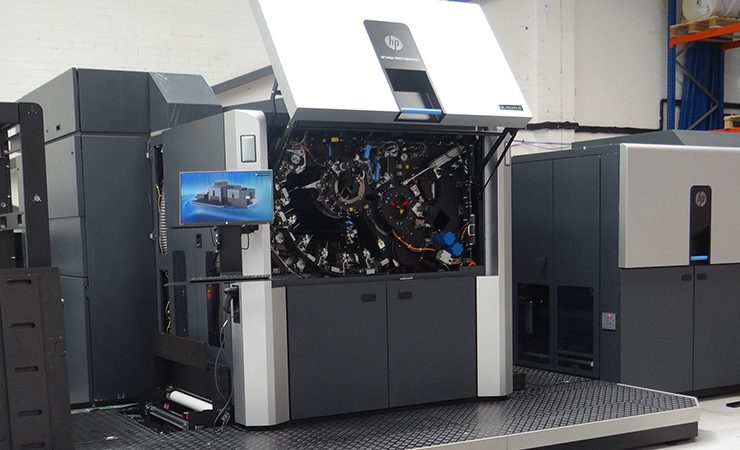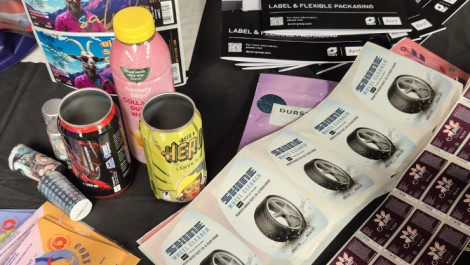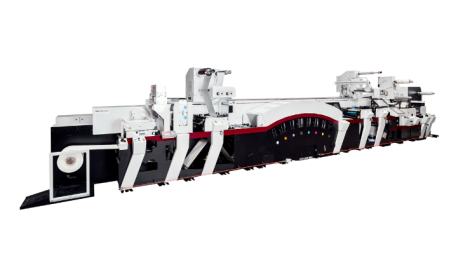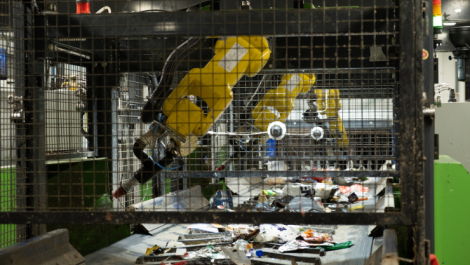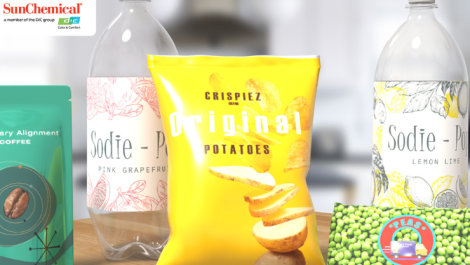Through its latest series of investments, UK trade printer Baker Labels has moved to establish itself as a recognised supplier of digitally printed flexible packaging.
Bakers has already built a strong reputation as a supplier of labels to trade customers, utilising both conventional and digital technologies. Its equipment portfolio includes HP Indigo WS6X00 digital presses, Screen Truepress Jet L350UV/+LM models and a Nilpeter FB-3, alongside a number of finishing systems, principally from AB Graphic. Its jobs cover a range of applications and end uses, with labels produced using liquid electrophotographic, inkjet and flexo printing, and finished with lamination, varnishing, embossing, foiling, foil doming, thermochromic and colour-shift inks, and holographic effects.
Sachets and shrink sleeves have provided Bakers with a foot in the door of the digitally printed packaging market, but managing director Steve Baker is now looking to take the company deeper into flexible packaging. Short runs of flexible packaging are often cited as being too small for conventional packaging manufacturers to take on. But with growing demand for versioning, limited editions, just-in-time delivery and smaller formats, narrow web printers, specifically label printers with their experience in digital printing, are perfectly positioned to take advantage of the opportunities.
‘The time is right,’ said Mr Baker. ‘Demand in the market is there, the volumes are there for us as a label business to make good margins and the technology is there.’
This is evidenced further by the creation of BakPac, a new division of the company to offer trade digital flexible packaging. Phil Smith has been appointed as the man to lead BakPac, with Mr Baker previously having said, ‘We have been growing rapidly over the last few years and the plan is to keep building, investing and growing, potentially into new areas of the print and packaging industry. We have some big plans ahead that created the need for another manager.’
Referencing the success of the ePac business model in the USA, which is now being brought to Europe, Mr Baker continued, ‘It’s clear to see that the opportunities are there. If you look at where someone like ePac Flexible Packaging has come from [the company was founded in 2016] to where it is now and where it’s going [20+ sites in the US and an operation in Europe], the growth has been immense. Yet in the overall packaging industry, it’s a drop in the ocean. For a traditional packaging company, such work is of small value to them. For us as a label printer, it’s good business.’
20000 reasons
Mr Baker has now overseen investment in a 76cm-wide (30in) HP Indigo 20000 digital press. The Series 4 HP Indigo digital press is marketed as a viable tool for producing flexible packaging digitally, with a width more suited to the applications involved coupled with the inherent advantages of digital printing – versioning, speed to market and smaller runs.
Bakers is further augmenting its capability to produce digital flexible packaging by investing in laminating and pouch making technology. These will allow it offer a full service to its potential customer base for flexible packaging.
‘We want to have full control of the process, which is why we’re adding laminating and pouch making,’ said Mr Baker. ‘Key is the ability to offer a fast turnaround. If you’re outsourcing converting, it’s going to add weeks on. Eventually we want to be able to offer a turnaround of less than two weeks.’
While the HP engine has already been installed, the laminating and pouch making are to follow later this year. Mr Baker anticipates that the company will be fully operational with its flexible packaging offer by the start of next year, although print trials are being offered now.
Bakers will be using its digital flexible packaging service to target higher value business, as it does with its label customers. ‘We are doing a lot of work with embellishment and high-end labels, where a higher level of investment is needed. This is the niche we want to operate in. With the number of reconditioned presses we see going into smaller print houses, it is not possible to compete with that business model where they have low overheads and are turning out jobs and keeping the press filled.
‘We are not concerned about filling the press, more with how to handle the volume of work we anticipate to come in. With our existing customer base, we have a good 300 potential customers. It will only take a small percentage of that number to fill the capacity we’ve got. We won’t be looking to just grab work. Rather, we want to be working in a niche within a niche within a niche.
‘Flexible packaging is not going to cannibalise our business either. It’s likely we will be working with markets that don’t exist at the moment. Having this capability will help generate more and more business, and create its own work.’
The investment in a second Screen inkjet press earlier this year also fits into Bakers’ flexible packaging equation. Opting for a Truepress Jet L350UV+LM model, Bakers has installed a press designed to offer food-safe packaging production by running low migration inks and integrating a nitrogen purge mechanism. This reduces the density of oxygen to an absolute minimum, accelerating curing of UV inks. Compliance with important legislation has also been achieved, such as with the EuPIA Exclusion Policy for Printing Inks & Related Products, Swiss Ordinance and Nestlé Guidance.
The output from the Screen presses, and older generation HP Indigo machines, are to be compatible with the forthcoming flexible packaging converting hardware at Bakers. A double unwind unit will allow facestocks and base materials run off the older digital presses to be combined to create bespoke flexible packaging constructions using different materials.
#trusttrade
Being able to specialise its output in such a way is another means for Bakers to create USPs for itself. The printer has also been publishing and sharing light-hearted videos via social media to promote its position as a trade printer. Accompanied by the hashtag #trusttrade, it has talked up its market position, capabilities, expertise and resources made available to customers.
‘As a trade printer, we have to understand what our USPs are,’ noted Mr Baker. ‘There are lots of reasons to use a trade printer. And we, as a trade printer, must invest in new kit and ways of working, have new ideas and items to bring to market.
‘We have built a strong reputation within the label market and must now get ourselves known and understood by the larger packaging companies as their go-to for short-run flexible packaging.’
He concluded, ‘Producing primary packaging such as flexible packaging is obviously a big learning curve compared to secondary – labels – but I am confident in our ability to master it. And while we might not yet know all the nuances of flexible packaging, we do know digital printing.
‘There will always be demand for short runs, so we’ve got to get our name out there as that supplier. The work will follow. I am confident that we will make a success of our move into flexible packaging.’
Read more from Steve Baker in his ‘My Digital Journey’ interview, published in the May/June 2019 issue of Digital Labels & Packaging

